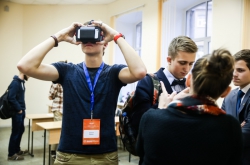About himself
I’d say I have a “compound” education. As a child, I thought of becoming a scientist, and got the corresponding training: I diligently studied physics and math. On the other hand, a person who’s well-known at ITMO University, Vladimir Parfenov, once brought us, still school students, together, and told us about programming competitions. This was back in 1994, when ITMO’s team didn’t win almost everything it participated in. Still, its members had already made it to the finals of different contests, and could apply for great well-paid jobs. This also got me really interested, and I decided to take up programming.
For some time, I had been focusing on both fields and couldn’t decide which I liked better. On one hand, I studied quantum field theory, and on the other, I did programming.
About programming
At the time when I started, studying programming wasn’t easy, as we literally had very few to work with. My friend and I, the two of us used a single PC; actually, it was his computer, and I just joined him: I already knew some programming and he didn’t, so we collaborated.
By the way, despite his lack of programming skills, he still managed to get a great job. How come? Well, this story can make a good example for anyone. He went to an interview and, as he knew nothing, put down everything he was told. The employer was so impressed with his diligence that he gave him a very interesting project. In the end, we worked on it together, on that single PC. We worked in shifts: one worked, then passed his turn to the other and went to sleep, while the other picked up from where he left, and so on. It took us three months to complete the project. In this time, by just working as hard as he could, my friend learned to code, and eventually founded his own startup that he sold for a hundred millions. So, if you work really hard, you can accomplish a lot.

On switching to science
Having spent 15 years on programming (Vasilii Philippov was co-founder and chief operating officer of SPB Software. The company started as a small team of enthusiasts, but soon attained international leadership positions in selling apps for Windows Mobile, with offices in six countries. In 2011, the company was bought by Yandex. -- Ed.), I decided to try combining science and programming once again. By that time, I already had kids, and when you watch your kids grow, you start thinking about many interesting things.
As an example, let’s take the atomic structure. What binds the electron to the atom? For some reason, many children believe that it’s gravity. I had to disillusion them and tell them that gravity doesn’t have much part in that: the electrostatic forces are a lot more important in this matter. Then, they asked me a logical question: why do we even study gravity? What’s the point?

The situation with science has a lot in common with this gravity issue. Just imagine an ordinary scientist who simply does their work. Wars rage around, politicians influence the fates of many people, and the scientist just does their thing. Check out Forbes’ Most Powerful People List and you won’t find a single scientist there. It may seem that scientists don’t have much influence on our lives. Still, if we were to look back at the past 100-200 or 500 years, it becomes evident that discoveries made by scientists had a great effect on our world. In the longer run, it is science that makes history, not particular political decisions or events.
When I got 40, I thought: what’s next? I knew I couldn’t accomplish much in science at this age, so I decided to try myself in the field of education. As I possessed some skills in programming, I started thinking of ways for applying them in order to give children better education.
How VR helps understand science
Do you remember the chemical equation for the combustion of hydrogen? You’re right, hydrogen plus oxygen gives water. Still, what really happens on the inside? I remember the formula from school, and that it’s 2H2O that we get in result. But five years ago, I still hadn’t the slightest idea of how it actually happens. And this is what always bugged me: we learned the formulas by heart but never understood what they actually meant.

In my opinion, the best thing we can do is to explain chemistry to children in a different manner: make it so that they won’t simply write down formulas but show what actually happens during a reaction. This approach is quite complex, as we have to simulate these phenomena.
In this sense, VR is a very cool instrument, as it makes it possible to look at any process in detail. And that is education brought to a whole new level: as opposed to studying the formulas, children won’t easily forget the processes they saw with their own eyes (MEL Chemistry VR is one of the services offered by MEL Science).
Issues of working with VR
The approach I mentioned implies having a virtual reality that actually works. Unfortunately, there are still issues to be solved in this regard.
When I was still doing programming, we developed programs for the so-called palmtops. Those were handheld computers before smartphones, which appeared later. In 2005-2006, it became evident that this technology was really cool, even though it had many bugs: the battery died too soon, they were a bit slow and so on. Still, as people working in this field, we understood that such problem could be solved in a couple of years’ time. Indeed, in 2007, we got iPhone, then there was the rapid development of Android, and everything became great.
The situation with VR is very similar to the development of smartphones in those years: the technology already exists, but there are still many small issues to be solved.
Problem #1: When you are going somewhere on a ship, you might feel sick. Unfortunately, it’s possible to experience a similar problem with VR (this is a common issue with the Google Cardboard headset).

Why do we get motion sickness? It happens when your vestibular system gives you a wrong signal: you sit in a cabin and look at what seems to be a motionless wall, but your vestibular system senses movement. This makes your body mad, as it knows that under normal circumstances, there’s only one explanation to it: you’ve been poisoned. So it hurries to clean your stomach, and you get sick.
The same happens when you’re using VR: you turn, but your headset doesn’t show it, or the timing isn’t exactly right. When they created Google Cardboard, no one optimized the sensors for the real-time mode, so the images you saw changed with a slight delay, and the brain automatically thought that it has been poisoned.
In order to solve this problem, it’s necessary to eliminate this delay. This issue is already being solved, and modern devices have almost no delay to worry about.
Problem #2: Though modern devices have been optimized to work in real-time mode, the motion sickness problem still manifests when you move your head without turning it. The device fails to notice such movements, as it doesn’t have motion sensors. Therefore, new generations of headsets have to solve this issue; one of the ways of doing that is fixing the device with several cameras that track the user’s movements.

Problem #3: When you are watching a movie in 3d glasses, you can get a headache by the time it ends. Why? While you watch, your eyes try to focus on something: if you’re looking at something that’s close, you see it more distinctly, and the rest of the image gets blurred. In VR, it’s all different: you see one image with your right eye and a different one with your left. And this is not what your brain is used to. Luckily, you don’t get sick, but you still feel uncomfortable. The brain is actually very sensitive to our attempts to trick it.
So, how can we get around this kind of a situation? We can either use small cameras to track our eyes’ movements, there already are prototypes of such devices, or do it similar to what they use for Magic Leap, where there are several “layers” for various focal distances, and the eye can focus on those. As opposed to the previous two problems, this one is yet to be solved.

Problem #4: Another problem has to do with controlling VR devices. In this sense, Google Cardboard was really inconvenient. Nowadays, the most popular solution is trackpads. Sensors are also quite popular: you just move your hands, and the device tracks these movements. Personally, I believe that the latter is more convenient. Leap Motion already developed solutions that allow to track such movements with no additional devices, and I think those will be fully optimized in some year’s time.
Problem #5: Remember how Steve Jobs presented the Retina display in 2010? What was so new about it? The screen’s resolution of a smartphone held at arm distance corresponded to that of the eyeball. And everything’s great, as long as you keep this distance. Still, if the screen is almost next to your eyeball, the resolution is just not enough. This problem is yet to be solved, but we can expect a working solution in some ten years.
Why VR won’t ever become a huge business, but can still change the educational system
On the whole, the above-mentioned problems aren’t anything big. They are just technical issues that will be solved in the coming decades. The most important problems are social ones. For example, when waiting for a meeting or a lecture, you can zone out with a smartphone, and this is ok. Still, you can’t do that with VR, as you become too out of touch with reality.

There is a multitude of VR-related scenarios that are socially unacceptable, and that kills most opportunities for the commercial development of this technology. So, it’s highly improbable that VR will ever become a trillions-worth business like the Internet or smartphones. It will always be a niche business.
Still, the use of VR in education is nothing wrong. What’s more, VR allows to immerse students into any kind of environment, show the “insides” of a cell or a chemical reaction, for example. So, what kind of effect can it have in the field of education?
To my mind, the biggest problem in learning science is the abstract nature of its concepts. Oftentimes, science is about things happening in microscale, which are invisible to us, and that is already hard for children to understand. Explaining the workings of an invisible world is even harder. Virtual reality is something that can help translate abstract concepts into something you can “touch”. It offers us many instruments we never had before, and all we have to decide on is how to apply them.




